#Giuseppe Balbo
Photo

Giuseppe Balbo (1902 - 1980) - Autoportrait, 1927
64 notes
·
View notes
Text
Nel 1975 Pelosini allestisce una antologica a Bordighera presso il Palazzo del Parco
Fernando Pelosini, Ilvallone del Sasso a Bordighera. Fonte: art. Idal cit. infra
Fernando Pelosini dopo aver frequentato l’Istituto Professionale di Savona nel 1942 inizia la sua attività artistica.Fra il 1945 ed il 1946 a Bordighera segue gli insegnamenti di Giuseppe Balbo.Nel 1947 inizia a frequentare lo studio del pittore Giuseppe Ferdinando Piana con cui si perfeziona ulteriormente e con cui…
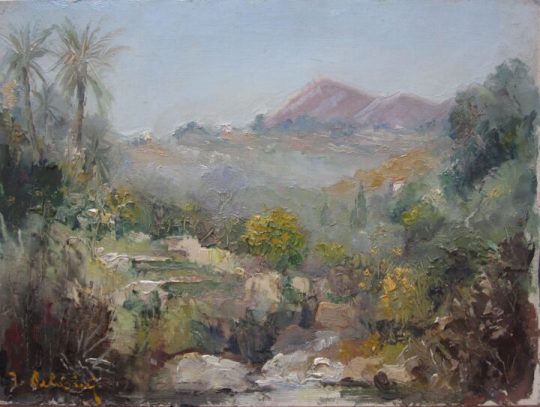
View On WordPress
0 notes
Text
Nel 1975 Pelosini allestisce una antologica a Bordighera presso il Palazzo del Parco
Fernando Pelosini, Ilvallone del Sasso a Bordighera. Fonte: art. Idal cit. infra
Fernando Pelosini dopo aver frequentato l’Istituto Professionale di Savona nel 1942 inizia la sua attività artistica.Fra il 1945 ed il 1946 a Bordighera segue gli insegnamenti di Giuseppe Balbo.Nel 1947 inizia a frequentare lo studio del pittore Giuseppe Ferdinando Piana con cui si perfeziona ulteriormente e con cui…
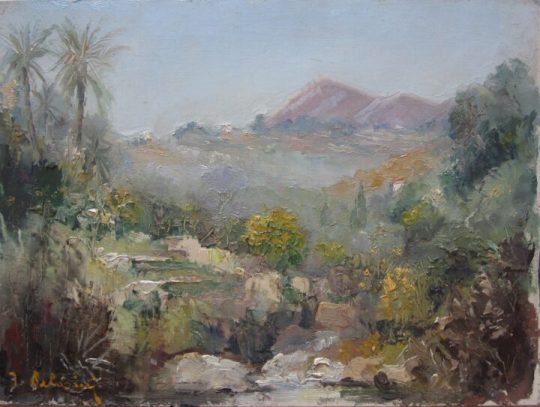
View On WordPress
0 notes
Text
Hello there!
Hey everyone, my name is Beatrice but you can call me Bea. I'm new in the reichblr so I would like to introduce myself to this community! (Hoping not to get banned ffs)
I'm from Italy (insert italian theme song) and I am 17 years old (born in 2007) so I'm a minor, I go by She/Her.
WWII has to be my favourite historical period alongside the ancient one. I have a passion over Nazi Germany, NOT because I support the ideologies and what they did, but because I find them unique to study, I have a lot of books about them! My favourite historical figures are Reinhard Heydrich, Heinrich Himmler, Joachim Peiper, Michael Wittmann (in the past) and Erwin Rommel (my grandpa always told me lots of stories about him so I got interested).
I DON'T support the ideologies, propaganda and the atrocities that happened, I'm totally against them.
I'm an active roleplayer so in case you want to do a WWII rp, I'm here.
I'm an artist, maybe I will post some of my drawings here...
Movies? Yes. The ones I liked the most were "Operation Anthropoid", "Hitler: The Rise of Evil", "The Man with the Iron Heart" and "T-34". Documentaries? Of course. "Hitler's Circle of Evil" is indeed perfection.
As much as I love the Third Reich history, I'm also very passionate about Fascist Italy. My favourite historical figures are Galeazzo Ciano, Italo Balbo, Dino Grandi and Giuseppe Bottai.
My DMs are always open if you'd like to talk about history or to just get to know each other. I will gladly accept to have new friends who share the same passion ^^! 💫🖤
57 notes
·
View notes
Text
Non solo Atreju, dai fischi di Craxi al Gabibbo di D'Alema: i leader a casa dell'avversario

(Adnkronos) - "Mi si nota di più se vengo e me ne sto in disparte o se non vengo per niente?". La domanda di Nanni Moretti in Ecce Bombo, i leader politici italiani se la sono posta eccome. Tutte quelle volte che hanno ricevuto un invito da un avversario. Come il caso di Elly Schlein che ha detto 'no, grazie' ad Atreju, la festa di FdI. O quando hanno avuto l'opportunità di ritrovarsi in un contesto particolare, non 'confortevole' politicamente.
Berlinguer al Congresso Psi
Nella primavera del 1984, per la politica un altro mondo, Enrico Berlinguer fa il suo ingresso al congresso del Psi di Verona. Lo accoglie una bordata di fischi. Impassibile, il segretario del Pci siede al suo posto. Poco dopo, dal podio, tra le lunghe pause che sempre riempivamo i suoi discorsi, Bettino Craxi spiega: "So bene che non ci si indirizzava a una persona ma ad una politica che noi giudichiamo profondamente sbagliata. E se i fischi erano un segnale politico che si manifestava contro quella politica, io non mi posso unire a questi fischi solo perché non so fischiare".
Berlinguer, suo malgrado, è protagonista di un altro episodio rimasto nella storia. Alle esequie del leader comunista, nel giugno dell'84, si presenta Giorgio Almirante. "Sono venuto per salutare un uomo onesto", dice il leader Msi varcando la soglia di Botteghe oscure. Massimo Magliaro, ex braccio destro di Almirante, ha ricordato più volte: "All’uscita mi disse, telefona a donna Assunta. Dille che è andato tutto bene". Non molti anni dopo, nell'88, furono Giancarlo Pajetta e Nilde Iotti a rendere omaggio alla salma di Almirante ai suoi funerali.
Fini alla Festa dell'Unità
Altri tempi, altri scenari. Ma la sostanza del leader che decide di varcare la soglia della 'tana' dell'avversario non cambia. Nel '95 Walter Veltroni invita Gianfranco Fini (che accetta) ad un faccia a faccia alla festa dell'Unità: "Il valore della festa è questo, confrontarsi tra schieramenti avversari con rispetto e nel comune obiettivo di lavorare per il bene del Paese", dice Veltroni.
L'album dell'94 è invece pieno di foto di Indro Montanelli sotto il simbolo della Quercia: il giornalista è ospite d'onore alla festa dell'Unità di Modena, accolto con una standing ovation (Montanelli ha appena litigato con Berlusconi e lasciato il 'Giornale'): "Vi prego, basta applausi, ve lo chiedo per legittima difesa", implora il giornalista. Foto per foto, resta negli annali quella del '96 del Gabibbo con Massimo D'Alema, in visita agli studi Mediaset: "Un’azienda che è un patrimonio per l’Italia", dice il segretario del Pds.
I faccia a faccia ad Atreju
Poi, con il passare degli anni, la politica cambia. Aumenta la quota spettacolo. E i faccia a faccia insoliti tra i leader si moltiplicano. Atreju ne ha fatto un marchio di fabbrica. Alla festa di FdI si sono visti, negli anni, Silvio Berlusconi, Fausto Bertinotti, Rosy Bindi, Walter Veltroni, Luciano Violante, Nicola Zingaretti, Giuseppe Conte, Luigi Di Maio, Matteo Renzi, per citarne alcuni. Tutti, spesso, vittime di scherzi e spietate goliardate dei giovani 'fratelli'.
Memorabile l'ospitata dell'allora ministro dell'Interno Marco Minniti, nel 2017, accolto da qualche fischio ma uscito tra applausi scroscianti dopo aver deliziato la platea con un paio di aneddoti. Il primo, quando si ritrova nella storica stanza di Italo Balbo: "Era enorme!". Il secondo, particolarmente entusiasmante per la platea, quando da neo sottosegretario alla presidenza del Consiglio finisce alla scrivania che era stata di Benito Mussolini. "Giuliano Ferrara scrisse, quella scrivania era in buone mani!".
Giorgia Meloni al Congresso Cgil
Non solo Atreju, però. Giorgia Meloni, nel marzo scorso, è intervenuta al Congresso della Cgil, invitata e poi accolta da Maurizio Landini con una storica stretta di mano. E sempre la premier, ai tempi 'solo' leader di Fdi, ha regalato una fulminante battuta al termine di uno degli innumerevoli faccia a faccia (tra convegni e presentazioni di libri) con l'allora segretario del Pd Enrico Letta: "Siamo i Sandra e Raimondo della politica italiana".
[email protected] (Web Info)
Read the full article
0 notes
Text
Vincenzo Costanzo joined the children’s choir of the Teatro San Carlo in Naples at the age of six. He made his debut as a soloist at the age of 11 in a contemporary opera, again at the Teatro San Carlo. He studied piano and solfège in a private school, and then obtained his degree at the local conservatory. At the same time, he graduated in Computer Engineering, continuing his singing studies with Marcello Ferraresi, and then perfecting his skills with Piero Giuliacci. Despite his young age, Vincenzo Costanzo has already won an Oscar Della Lirica (New Generation Tenor award) in Doha (Qatar) in 2014, and has had the opportunity to work with internationally renowned directors and conductors such as Myung-whun Chung at the Teatro La Fenice in Venice and in Tokyo, James Conlon at the Teatro Real in Madrid, Emma Dante at the Teatro Massimo in Palermo, Daniel Oren and Franco Zeffirelli at the Arena di Verona and Liliana Cavani at the Gran Teatre del Liceu in Barcelona. His most recent engagements include Un Ballo in Maschera, Simon Boccanegra (Gabriele Adorno), Tosca (Cavaradossi), Maurizio Di Sassonia in Adriana Lecouvreur and Madama Butterfly (Pinkerton).
Dear Vincenzo, thank you for accepting our invitation! Now you are at Sabbioneta, at Teatro all’Antica, for a new project: Giuseppe Verdi’s La Traviata, alongside Elisa Balbo and Luca Micheletti. What can you tell us about this project? How did this idea come about? How is it going on so far?
Hello, dear readers of OPERA Charm. A few days ago we finished the shooting of La Traviata in the suggestive theater of Sabbioneta. It has been a wonderful experience, but unfortunately I can’t release any information about it because the project has not been announced yet. I can only give you a little spoiler: the technology used for audio and video shooting is totally innovative and unprecedented. You’ll hear about it soon.
To go a bit backwards: when did you feel for the first time that opera is your path and who are those who guided your first steps towards the stage? What’s the moment that you consider to be the actual beginning of your career?
In my family I am the only musician and artist. I have felt a vocation within me since I was a child. I took my first steps on stage at the age of 9 at the San Carlo Theatre in Naples and I identify the beginning of my career with the victory of the Voci Verdiane award in Busseto at the age of 21.
You had the chance to work with Daniel Oren, Franco Zeffirelli, Andrea Battistoni, Leo Nucci, Juraj Valcuha, Giampaolo Bisanti, Francesco Ivan Ciampa and many others. What each “gesture” has thought you and which of them had the most important impact on you as an artist until now?
I have been lucky enough to be part of the opera world since I was very young and every single person I have met during my journey has enriched me as a man and an artist. I could name a thousand episodes that have made me understand the sacrifice and dedication necessary for this ancient art.
reposted from https://opera-charm.com/
0 notes
Text


Amadeo Ferroli - Portrait de Giuseppe Balbo, 1931/Amadeo Ferroli - Autoportait, 1931.
1 note
·
View note
Photo
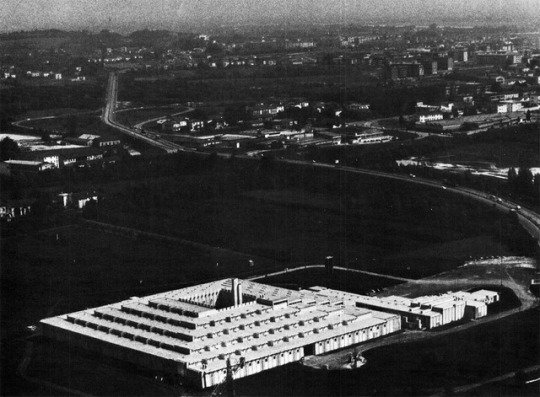




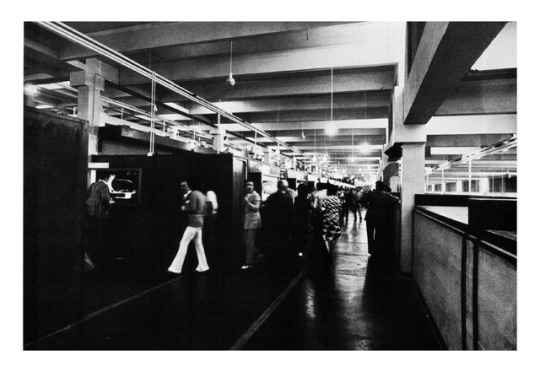


'Fiera di Vicenza' - exposition complex
Vicenza, Veneto, Italy; 1965-68
Giuseppe Davanzo, Paolo Balbo, Giandomenico Cocco
Pietro Maltauro, Pietro Pelzel
(photographs by G. Davanzo; Fotografia C&T)
see map | more information 1, 2, 3
via “(Das) Werk, 61” (1974)
#architecture#arquitectura#architektur#architettura#fiera#fiera di vicenza#exposition#exposition hall#exhibition#exhibition hall#giuseppe davanzo#paolo balbo#giandomenico cocco#pietro maltauro#pietro pelzel#fotografia c&t#vicenza#veneto#italia#italy#italian architecture
297 notes
·
View notes
Text
28 gennaio 1945, la "marcia della morte" dei generali italiani
28 gennaio 1945, la “marcia della morte” dei generali italiani
Il 28 gennaio 1945, durante una delle “marcia della morte” dai lager nazisti in Polonia verso i territori ancora in mano al Terzo Reich venivano trucidati dai soldati tedeschi ben sei generali italiani, fra i numerosi alti ufficiali catturati dopo la resa del Regno d’Italia dell’8 settembre 1943. Lo stesso giorno la tragica sorte toccava anche a un altro generale italiano che, dopo essere…

View On WordPress
#Generale Alberto Trionfi#Generale Alessandro Vaccaneo#Generale Carlo Spatocco#Generale Emanuele Balbo Bertone#Generale Francesco Antonio Arena#Generale Giuseppe Andreoli#Generale Ugo Ferrero#Generali Italiani#Internati Militari Italiani#Lager tedeschi#M;arcia della morte
0 notes
Link
5 notes
·
View notes
Text
Why Feuilly cares about Italy or “a lot of words to explain Hugo’s crush on Garibaldi”- part 4.1
Camillo Benso Count of Cavour

Here we are with the new post of this project, thank you for your patience, I know I’m so slow with these, but I’m really happy you’re all still interested.
If you’re new (or just need to refresh your memory) and you want to read the previous posts you can find them here, here and here.
Before actually talking about the Second Italian War of Independence, I thought it would be more helpful talking about two of the protagonists of this process: Camillo Benso Count of Cavour and Giuseppe Garibaldi. Let’s start with the probably less known of the two: Cavour.
Camillo Benso Count of Cavour was the second child of Michele Benso of Cavour and Adele de Sellon, and as many not-heir children at the time, he was destined to the career of arms. He was, from July 1824, page of Carlo Alberto, prince of Carignano, but was sent away in 1826, for a certain youthful intolerance of the rules and for his declared liberalism.
Army Officer since 1827, he was transferred as a punishment to the fort of Bard for having expressed consent to the July revolution in France. This prompted him to resign (November 12, 1831).
At the age of twenty-two, Cavour was appointed mayor of Grinzane where the family had possessions. From December 1834 he began to travel abroad studying the economic development of mostly industrialized countries such as France and Great Britain.
Accompanied by his friend Pietro De Rossi Di Santarosa, Cavour reached Paris in February 1835, where he stayed for almost two and a half months: he visited all kinds of public institutions and attended the political circles of the July Monarchy. Leaving the French capital, on May 14, 1835, he arrived in London where he became interested in social issues.
During this period the young Cavour developed that conservative way of thinking that will accompany him throughout his life, but at the same time, he felt strongly growing interest and enthusiasm for the progress of the industry, for the political economy and for free trade.
Back in Paris, between 1837 and 1839 he attended the Sorbonne assiduously and met, in addition to various intellectuals, the exponents of the monarchy of Louis Philippe, of which he maintained a lively admiration.
His political faith soon reached a firm basis: the “juste milieu”, the aversion to reaction and revolution. He thought to have found his call in the field of agriculture and as the administrator of the family assets: he infusing in these activities the spirit of a modern businessman.
Back in Piemonte, in the midst of the distrust of conformist circles, Camillo thus became part of the subalpine (the region of Italy just under the Alps, so Piemonte, Lombardia and Veneto) reform movement, to which he cooperated both with direct initiatives ( he promoted kindergartens and nursery schools; in 1839 he was a member of the superior commission of statistics; he was one of the founders of the Agricultural Association), and with his work as a publicist in the Bibliothèque Universelle in Geneva, in the Revue nouvelle in Paris, in the Italian Antologia of Turin.
The reform of the law on the press (which had become more free after 1848 in the Kingdom of Sardinia) allowed Camillo to enter real politics, with the foundation (1847) of the moderate newspaper “Il Risorgimento” where he became a supporter of a Constitution (a real one, not the Statuto Albertino conceded in 1848), though accentuating, especially after the Paris revolution of 1848, a conservative line of thinking (census suffrage and single-member college).
The Five Days of Milan pushed Camillo from internal political problems to those of foreign policy and the famous article “The supreme hour of the Savoy monarchy” supported the immediate intervention in favor of the insurgents.
He was elected deputy in the elections of June 26, 1848, but he was beaten during those of the 22nd of January.
In 1849, he was favorable to the intervention in Tuscany against the revolutionary party and against the resumption of the war against Austria.
He was re-elected in March 29, 1849, and he supported the Ministry D’Azeglio against the left movements, but after the proclamation of Moncalieri (addressed to the Piemontese people by Vittorio Emanuele II, after the dissolution of the Chamber: he urged the election of a majority in favor of the peace of Milan stipulated with Austria and to which the Chamber had been opposed for the too onerous clauses imposed on the Kingdom of Sardinia), to whose preparation he did not take part, and after the elections of December 9, 1849, which marked the defeat of far-left tendencies, he changed his political views by identifying the danger no longer to the left but to the right.
Meanwhile, the parliamentary position of Camillo had been consolidated: he made the first great affirmation of his political program on 7 May 1850, defending the Siccardi’s laws (which restricted the privileges of the clergy) in front of the Chamber. In 1850, he entered in the cabinet of D’Azeglio as Minister of Agriculture and Commerce. On April 19, 1851, he assumed, instead, the Ministry of Finance and with a loan abroad and with new taxes he managed to solve the financial problem, releasing Piemonte from financial subjection to the Rothschilds, a family of bankers.
However, the technical problems did not distract Camillo from the general politics and, in the face of D'Azeglio's moderate attitude, he agreed in May 1852 with the center-left of Ugo Rattazzi (a pact also known as the "Union"), thus preparing the fall of the Cabinet.
From this moment, began the great policy that led to the completion of the Italian Risorgimento.
He was forced to resign by the president of the Council on 16 May 1852 and he left the political scene with a trip abroad, but on November 2, 1852, Camillo was designated, by Vittorio Emanuele II who had tried in vain to entrust the government to the head of the right-wing Balbo, as the new president of the Council.
He immediately started a feverish activity, implementing almost completely free trade, he eliminated many privileges of the aristocracy, he hired the best of the political exiles in the state administration, he established the suppression of religious corporations and un-used territories. All these reforms brought him to clash with the king who forced him to resign in 1855 but had soon to appoint him back again.
With this victory, the parliamentary regime triumphed in Piemonte on the king's personal power. Strengthened by its liberal institutions, the Kingdom of Sardinia was invested with a national mission: the alliance with France and England with the consequent expedition to the war of Crimea.
What is the war of Crimea you ask? Well, it was a Conflict that went on from 1853 to 1856, for the control of the Balkans and the Mediterranean which opposed Russia to the Ottoman Empire, supported by France and Great Britain. The pretext had been the Sultan's refusal to accept Russia’s request to protect the Greek Orthodox subjects of his empire. When this request was rejected, the Russian troops occupied Wallachia and Moldavia, and the Turks, backed by Western powers, declared war.
This is very interesting, you might say, but why Camillo Benso thought was so important for the Kingdom of Sardinia to take part in this war beside France and England? Because it was this expedition to give Camillo the right to talk about the Italian question (meaning the fact that Italy wanted to become independent) during the Paris Congress for the first time.
The realization of this program proceeded nevertheless with an incessant struggle on two fronts: against the clerics and conservatives which became threatening after the 1857 elections, and which Cavour contained by sacrificing the pact with the left wing party and waving the specter of Mazzinianism (which was synonym with republicanism) and social unrest, and against the ultra-democrats.
What happens next it’s the history of the Second Italian War of Independence and we’ll deal with it after talking about Garibaldi. So stay tuned, see you in the next post!
21 notes
·
View notes
Text
All’artista Marcello Cammi interessava il significato che va al di là dell’apparenza
Un’opera abbandonata di Marcello Cammi. Fonte: Marco Farotto, art. cit. infra
Marcello Cammi nasce a Sanremo il 14 aprile 1912 da Paolo Cammi ed Emma Musi (il padre Paolo ebbe dalla prima moglie Luigia Gautier due figli Alfredo e Ester, mentre dalla seconda nacquero Iole, Ines, Ernesto, Giovanni e Marcello) e muore a Bordighera il 3 novembre 1994. Ancora bambino e orfano di madre si trasferisce…

View On WordPress
0 notes
Text
All’artista Marcello Cammi interessava il significato che va al di là dell’apparenza
Un’opera abbandonata di Marcello Cammi. Fonte: Marco Farotto, art. cit. infra
Marcello Cammi nasce a Sanremo il 14 aprile 1912 da Paolo Cammi ed Emma Musi (il padre Paolo ebbe dalla prima moglie Luigia Gautier due figli Alfredo e Ester, mentre dalla seconda nacquero Iole, Ines, Ernesto, Giovanni e Marcello) e muore a Bordighera il 3 novembre 1994. Ancora bambino e orfano di madre si trasferisce…

View On WordPress
0 notes
Text
Hey, can I copy your homework? (Fascist Italy edition)
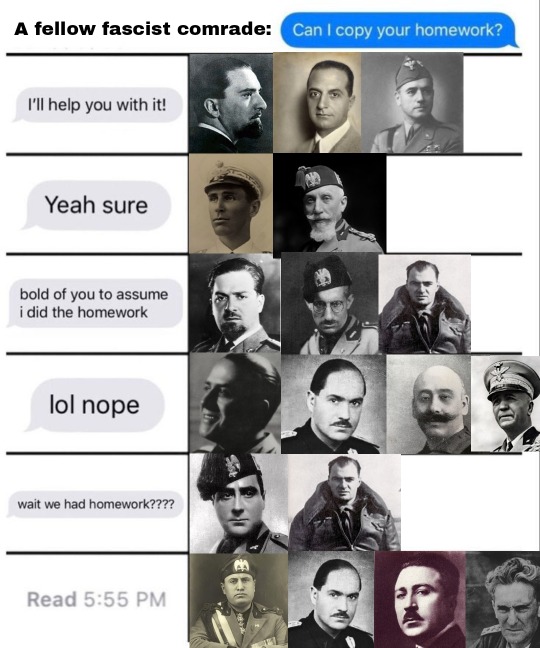
So, it's been a while since I posted my last meme. Have this new one, but Fascist Italy edition!
Take this as a joke. Please.
--------------------------
Name of the protagonists in order of appearance:
I'll help you with it!: Dino Grandi, Giuseppe Bottai, Giovanni Messe
Yeah, sure: Amedeo d'Aosta, Emilio De Bono
Bold of you to assume I did the homework: Italo Balbo, Michele Bianchi, Ettore Muti
Lol nope: Galeazzo Ciano, Alessandro Pavolini, Cesare Maria De Vecchi, Pietro Badoglio
Wait, we had homework??: Achille Starace, Ettore Muti
Read 5:55PM: Benito Mussolini, Alessandro Pavolini, Roberto Farinacci, Rodolfo Graziani
17 notes
·
View notes
Text
Di L. Bottura
Fervono i preparativi per il Reddito di cittadinanza, per il quale è già possibile presentare le domande in ordine alfabetico (forse per il timore che possa fruirne anche Zingaretti) pur in assenza di navigator. I consulenti di chi cerca lavoro sono infatti in fase di selezione attraverso un test di cultura generale del quale sono fortunosamente riuscito – l’aveva dimenticato Vito Crimi alla buvette, infatti i fogli erano tutti unti – a recuperare una copia. Rispondete alle domande e saprete se anche voi potrete uscire dalla disoccupazione insegnando ad altri come uscire dalla disoccupazione che al mercato mio padre comprò.
La Terra è…
A) Rotonda
B) Piatta
C) Stata rovinata dal Pd
Inventò il telefono
A) Antonio Meucci
B) Alexander Bell
C) Gino Nokia
Anno di scoperta dell’America
A) 1492
B) 1942
C) Ancora? La Terra è PIATTA!
Popolare linguaggio di programmazione
A) Uno
B) Dos
C) Tres, un pasito bailante Maria
Quanto durò il Ventennio fascista?
A) Vent’anni
B) Destra e Sinistra sono categorie superate
C) Comunque ha fatto anche cose buone
Scrisse i Promessi Sposi
A) Alessandro Manzoni
B) Federico Moccia
C) Maria De Filippi
Chi fu l’ultimo Re d’Italia?
A) Umberto II
B) Emanuele Filiberto
C) Pupo
Scrisse “La giornata d’uno scrutatore”.
A) Italo Calvino
B) Italo Balbo
C) Italo Treno
Il corpo umano è composto…
A) In massima parte da idrogeno, ossigeno, carbonio, calcio e fosforo
B) Della stessa materia di cui sono composti i sogni
C) Al 90 per cento di acqua
L’area del cerchio…
A) Raggio per raggio per PiGreco
B) Raggi per raggi per cassonetto
C) Si trasforma in un raggio missile coi circuiti di mille valvole
Musicò “La Traviata”
A) Giuseppe Verdi
B) Giulia Sarti
C) Nek
Qual è il più lungo tunnel ferroviario italiano?
A) La galleria tra San Benedetto Val di Sambro e Vernio
B) Il tunnel tra Ginevra e il Gran Sasso
C) Il tunnel tra il Brennero e il Polo Nord
Soluzione Esatto. Se avete risposto sempre C, o siete assunti o siete Luigi Di Maio.
10 notes
·
View notes
Photo

Giuseppe Balbo (Bordighera, 1902 - Ventimiglia, 1980), Uva su specchio, 1979 - olio su tela 40x30 - Fonte: Marco Balbo di Bordighera (IM)
0 notes